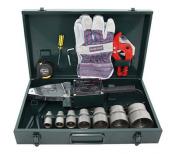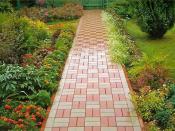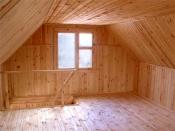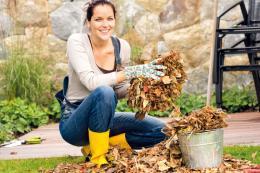Search
Login
Recommended
Autumn work in the garden and the garden, what needs to be done on the infield in the fall, useful tips
Autumn is the time of fogs and drizzling rains, rare sun rays with regret give their warmth to the yellowed leaves that have frozen in the wind. Every day it gets cooler, and look, one morning the first frost will appear on the grass.
But the owners of cottages do not have to give in to despondency, the autumn time is the time for completing all field work and harvesting, actively preparing for the winter. Fruitful work in the autumn garden is often the key to a rich harvest next year.
Content:
- September in the country, work in the country in September
- Autumn works in the garden, October
- November at the cottage
September in the country, work in the country in September
There is a lot of work in the garden and in the beds in September, all of it needs to be completed in a short time, sometimes it is difficult to even determine what to do first and what can be left for later. The main goals are harvesting and preparing garden plants for wintering.
garden care
September is the month of harvesting apples, in the first decade it is necessary to harvest late summer varieties, in the second - autumn, the third - to devote to harvesting winter varieties.

Autumn and late summer varieties are recommended to be processed, you can make juices, jam, jam, compotes from them. The best fruits of winter varieties, strong, without any damage, should be selected and stored.
In late September, late plums and pears are also harvested. They do this based on the ripening period, in most cases they are processed for the winter, but some are left to eat fresh. Winter pears can also be left for storage.

It is recommended to finish the harvesting of fruits before the beginning of leaf fall and the first frosts.
It will be necessary to pay attention to trees - so that the wood on the shoots of young non-bearing plants has time to ripen by the beginning of winter, it will be necessary to pinch strongly growing shoots.
Organic matter and mineral fertilizers will need to be added to the soil, it is recommended to loosen the soil itself, cover it with a layer of mulch. It is advisable to perform this work during the period of yellowing of the leaves, i.e. before the roots begin to grow actively. It is advisable to dig the earth with a pitchfork; they should be positioned so as to minimize damage to the roots of the tree. The depth of digging around the trunk of pears and apple trees is about 12 cm, plums and cherries - 8 cm.

Before the rains begin, dig holes for planting trees, autumn and planned for spring. Planting seedlings can be carried out in the last decade of September, in the same period, you can do planting raspberries and currants.
If a spring planting is planned, then the seedlings for the winter should be dug.
Fallen leaves are recommended to be raked out from under the trees and stacked in a compost heap. Some gardeners insist that the leaves should be burned in order to protect the garden from pests and pathogens.
Spoiled fruits falling from trees should also be removed, burned, or buried deeply.
In the event of lesion lesions by scab, it is necessary to spray urea on the apple trees before the leaf fall, take 400 g of urea on a ten-liter bucket of water, and 600 g of urea are bred on the same ten-liter bucket to till the soil.
Hunting belts are removed from the trees, pests that can be detected are destroyed. All branches should be carefully examined, patients - cut and burn.

The ground under the trees can be mulled with rags or peat, it is advisable to moisten them with smelling substances - they will scare away rodents.
If August and September turn out to be arid - the trees need to be watered abundantly - the dehydrated tree in severe frosts can dry out, the annual growth is most affected by a lack of moisture.
harvesting vegetables
With the beginning of September, they start harvesting late varieties of potatoes. The tubers are carefully sorted, dried well. For storage use cellars and cellars.

Carrots are dug up with the onset of the first frosts.

If it is removed earlier, it is advisable to keep it a couple of days in the refrigerator. The cooling stage is mandatory, it will prevent germination during storage.

When harvesting beets, you should clean it so that a small amount of its aerial parts remains.

Harvesting cauliflower should be tearing out plants with roots, they are installed in a box and lowered into the cellar. In the process of growing, the size of the inflorescences will increase significantly. If the cabbage is left on the bed - it is covered with a layer of non-woven fabric, thereby providing protection from the cold.
we plant garlic
In early September (or within a month, depending on weather conditions), garlic is planted:
- beds dig up
- make a bucket of humus and ash, in the amount of 1 liter per 1 sq.m
- sand - 1/2 bucket, if clay soil
- in the evening the garden is watered
To plant garlic, you will need 12 cm deep holes, the distance between which should be 15x15 cm. It is advisable to add a tablespoon of sand and ash to each hole, the planted clove should be covered with sand, and the soil should be leveled.

Garlic must have time to take root before the onset of frost, it is desirable that it does not sprout. But the plant itself is cold-resistant, it is not particularly afraid of frost. For the winter, it is advisable to insulate the garlic beds with straw, peat, or with fallen leaves. You can also expand the branches - for snow retention.
Similarly, you can plant a little onion in the fall - at the very beginning of spring, he will give green feathers that can be used to prepare vitamin salads.
Garlic does not like excess moisture, if it fills the bed, it will be necessary to take care of arranging the drainage system. To do this, you can dig a groove between the beds with a depth of 45-50 cm - the water will leave the beds.

As you can see, there are a lot of tasks, therefore, experienced gardeners recommend planning the order of work in advance, this will help to avoid rush. The owners of the cottage should also take time to relax - work should bring healthy fatigue, but not be a burden.
Autumn works in the garden, October
Since October is the month ending golden autumn in the middle lane, it is precisely at this peak of temperature instability that it can be almost summer-like warm during the day and frost at night. Those. gardeners will have to systematically monitor the weather forecast.

Even in one region, the temperature can vary significantly - near large cities it will be higher, in villages located in open spaces frosts are usually noted earlier. Those. Work schedules in the garden may be slightly shifted in time.
But it is still recommended that you familiarize yourself with and take into account the traditional list of works - in order not to forget or miss anything, choose the optimal time for this or that work.
prepare flowers for wintering
In the garden, you should continue planting bulbous flowers, such as tulips, hyacinths, lilies of the valley. It is recommended to mulch both freshly planted and previously planted plantings with peat, the layer thickness can reach 5 cm.
If the weather allowed, and you did not dig dahlia bushes, begonias and gladiolus before, then you should do this from the beginning of October, at plus temperature, on a sunny day. Wintering should be organized in a room with low humidity and a temperature of the order of +5 C, basements, attics, glazed balconies are suitable.

Perennial flower crops can be left for the winter in the open, it is recommended to cut off their stems, they should be burned with diseases, healthy ones can be placed in a compost pit. Soil on flower beds should be loosened, do not forget to fertilize.
Cereal crops can not be cut, they will give the garden a decorative effect in winter, and at the same time they will retain snow.
Do not forget to pay attention to rose bushes. From should be trimmed in accordance with the recommendations for the care of a particular variety, shoots that have not had time to ripen should be removed, the lashes of climbing roses should be shortened to the beginning of the lignified part.

Common to all types of roses is the need for mulching. You can use a mixture of sand with peat, about a bucket of mixture will be required for each bush. You can devote time to this work at the end of October or in November, when the temperature will remain stable at minus points.
continue to work in the garden
In gardens with fruit trees, the work that began in September should be continued:
- clean leaves and diseased fruits that were left on the tree
- to loosen the soil in trunks
- remove detected diseased and broken branches

You can also whitewash tree trunks. However, one can often find advice to refuse whitewashing - heavy autumn rains quickly wash off the paint layer, therefore, they will not be able to save the tree from sunburns received from the bright February and March sun, reinforced by snow.
Instead, it is recommended to wrap the trunks with a polypropylene cloth (sugar bags, after removing the polyethylene lining). In spring, bags should not be quickly removed - they protect well from the sun, let air through, the bark under them does not get wet.
Until the end of the month, it is advisable to plant all shrubs and trees with an open root system, with a closed one - it can be planted throughout the year, including in winter.
Prior to the start of severe frosts, it is possible to produce the crown of trees by pruning, remove old and dry infertile branches.
lawn care
You should not continue mowing the lawn; the recommended grass height for wintering is about 8 cm.
Remember that in the fall it is necessary to make fertilizers containing phosphorus and potassium, nitrogen should be discarded: growth stimulation on the eve of winter is absolutely undesirable.

Using a pitchfork or sandals with spikes on the sole, you should aerate the lawns.
prepare an artificial pond for winter
Preparing for winter will require an artificial pond on the site. We carefully clean it of fallen leaves and debris. To ensure clean water, you can pre-stretch a protective net over it.
It is also recommended to drain the water, but not all, in particular - if there are fish in the pond. To prevent ice from exerting destructive pressure on the walls of the reservoir, half-filled plastic containers should be immersed in water.

All equipment must be removed from the pond, cleaned, dried and stored.
Heat-loving aquatic plants should also ensure a good wintering, they should be stored all winter in containers, in ventilated cellars with a temperature of about 0 C.
we work on beds
Harvesting at such a time is usually already completed, but if October is warm, then you should not clean the zucchini and squash, they can please the fruits even in October.
Leeks can winter in open ground, but it is advisable to mulch the bed with it with humus, peat, sawdust.

Tops of tomatoes and potatoes should be burned, this will prevent the growth of late blight in the next year.
Work can be carried out with a significant decrease in temperature, but the soil should not be frozen, it is better if it is 2-3 degrees.
The beds intended for the spring planting of plants should be dug up, while the clods of earth from under the shovels are not broken - they contribute to the retention of snow, the saturation of the soil with oxygen and moisture. In addition, deeper freezing of the soil will lead to the death of larvae of garden and garden pests.
But digging beds after snow is not recommended - too deep soil moisture will create problems with the evaporation of moisture in the spring, which may delay planting.
don't forget indoor plants

Since the beginning of October, it is recommended to remove all indoor flowers into the house - on the street they will be too cold. Although no less stress awaits them there - the beginning of the heating season, and with it an increase in temperature and a decrease in humidity, which is quite harmful for plants.
November at the cottage
With the beginning of November, there may come a drop in temperature to negative levels, i.e. it's time for the final harvest. With the onset of November, the latest varieties of cabbage are harvested. The soil in the garden can be immediately dug up without breaking large clods of earth.

winter sowing of vegetables and flowers
Noticing that the ground began to freeze - sow the seeds:
- parsley and dill
- lettuce and cilantro
- radish and carrots
The beds after snow can be covered with a layer of peat or straw.

In early November, but if the weather is cold enough, you can conduct winter planting of seeds:
- matthiol and rudbecky
- poppies and asters
- cornflowers and eschholzias
- fragrant tobacco and calendula
Prerequisite: the temperature of the earth must be so low that the seeds do not begin to germinate in the fall. The main criterion for soil readiness can be the freezing of its surface layer.
flower care
Clematis is prepared for wintering by trimming the shoots of the third group, leaving three nodes above the ground. The ground part of the rudbeck, phlox, aconite, echinacea is cut off, leaving a stalk length of about 10 cm.

With the onset of frost, you can shelter rose bushes. To protect perennial flower crops from freezing, you can sprinkle them with earth.
You will need to check the stored tubers of dahlia and begonias, bulbs of gladioli - remove all that you find defects.
make soil reserves
Do not forget to prepare the soil for growing seedlings. Of course, you can buy it in a store for gardeners, but the use of soil from the beds has some advantages - when planting seedlings it is better to take root.
general work
Upon completion of work in the garden and in the beds, all equipment should be cleaned, washed and repaired, and hidden in a dry room.
The collected seeds of vegetable crops and flowers are sorted and laid in paper bags, labeled and stacked in a cool, dry place.
Before the start of frost, it is recommended to drain the water from the summer water supply. All containers, buckets, barrels, etc. should be turned upside down. All drains should be cleaned of fallen leaves. If there are unheated greenhouses and hotbeds - they are dismantled and canned.
decorative shrubs - how to organize a wintering
Prior to the first heavy snowfalls, it is necessary to tie the branches of thuja and juniper - snow and wind can break and rash them. It is too early to cover rhododendrons with skeletons with covering material, but it is recommended to bind fragile branches of the plant.

Young conifers also need protection from wind and frost.
So that in winter the hares do not damage the bark of young fruit trees, they are tied with fir branches, elderberry branches, and wormwood.
harvesting cuttings
In the second half of November, you can prepare cuttings for spring planting. In the period of a significant decrease in temperature and the absence of fruits and leaves, the cuttings acquire special strength, which will give rapid development with the beginning of spring.
It is quite difficult to organize high-quality storage of cuttings, because winters are now quite unpredictable, both in terms of rainfall and temperature. If the cuttings are harvested a little - it is best to keep them in the refrigerator. Large farms also use the method of storing cuttings in special refrigerators, with controlled temperature and humidity.

Experienced gardeners do not recommend planning the harvesting of cuttings for the winter, all work in the garden should be completed before the frost sets in.

The main task of November can be called cleaning the territory of the cottage and garden - they should immerse themselves in a winter dream clean and tidy.





